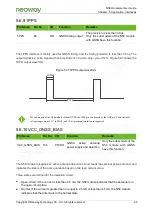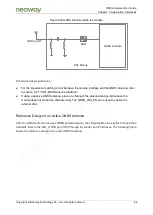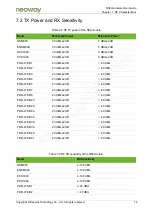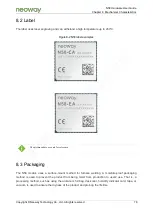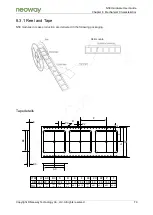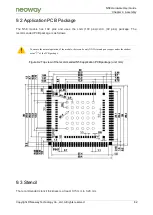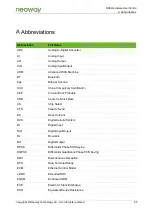
N58 Hardware User Guide
Chapter 6 Electrical Characteristics and Reliability
Copyright © Neoway Technology Co., Ltd. All rights reserved.
71
6 Electrical Characteristics and Reliability
This chapter describes the electrical characteristics and reliability of the N58 module, including the
input and output voltage and current of the power supply, the current consumption of the module in
different states, the operating and storage temperature ranges, and the ESD protection characteristics.
6.1 Electrical Characteristics
If the voltage is excessively low, the module might fail to start. If the voltage is excessively high or there is a
voltage burst during the startup, the module might be damaged permanently.
If you use LDO or DC-DC to supply power to the module, ensure that the output instantaneous current is at
least 2.5 A. The 2.5 A current occurs when the module is working at the maximum power level of the GSM
mode. The peak current during burst transmission has a short duration. Placing a large capacitor on the
VBAT pin of the module can effectively enhance the freewheeling capability of the power supply and
prevent excessive voltage drops that cause exceptions, such as module shutdown.
Table 6-1 Electrical characteristics of the N58 module
Parameter
Minimum Value
Typical Value
Maximum Value
VBAT
V
in
3.4 V
3.8 V
4.2 V
I
in
N/A
N/A
2.5 A
Table 6-2 Current consumption of the N58 module (typical)
Status
Frequency Band
Sleep
(mA)
Idle (DRX/eDRX)
(mA)
Active (mA)@max
power
FDD-LTE: B1, B2, B3, B4, B5, B7,
B8, B20, B28, B66
< 3 mA
< 16 mA
< 600 mA
TDD-LTE: B34, B38, B39, B40, B41 < 3 mA
< 16 mA
< 340 mA
GSM900/850
< 3 mA
< 15 mA
< 170 mA
GSM1800/1900
< 3 mA
< 15 mA
< 170 mA






